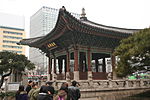Ilmin Museum of Art

Ilmin Museum of Art is a private art museum of South Korea, located on Sejongno street in Jongno-gu, a central district of Seoul, known for exhibiting mainly Korean art. The museum was established and run by the Ilmin Cultural Foundation (일민문화재단), a non-profit organization founded in 1994 in memory of Kim Sang-man (김상만 金相万 1910 ~ 1994), former president of Dong-A Ilbo, one of the major newspaper companies of South Korea. Kim devoted his entire life to developing Korean journalism and promoting Korean culture. The museum is named after his pen name, "Ilmin" (일민 一民, literally "one people"). On December, 1996, the museum opened as Ilmin Art Hall with 3 exhibition rooms in Dong-a Ilbo's previous location, built in 1926. The museum is based on the art collection of Ilmin acquired during his time. After undergoing a one-year renovation, the museum reopened on February, 2002. The building has five stories and the 650 m² facility. Ilmin Museum of Art also runs the only documentary archive of South Korea.
Excerpt from the Wikipedia article Ilmin Museum of Art (License: CC BY-SA 3.0, Authors, Images).Ilmin Museum of Art
종로 자전거 전용로, Seoul Jongno 1·2·3·4(ilisamsa)-ga-dong
Geographical coordinates (GPS) Address Nearby Places Show on map
Geographical coordinates (GPS)
| Latitude | Longitude |
|---|---|
| N 37.5699 ° | E 126.9775 ° |
Address
동아일보 사옥 (Dong-A Ilbo Office Building)
종로 자전거 전용로 152
03188 Seoul, Jongno 1·2·3·4(ilisamsa)-ga-dong
South Korea
Open on Google Maps





